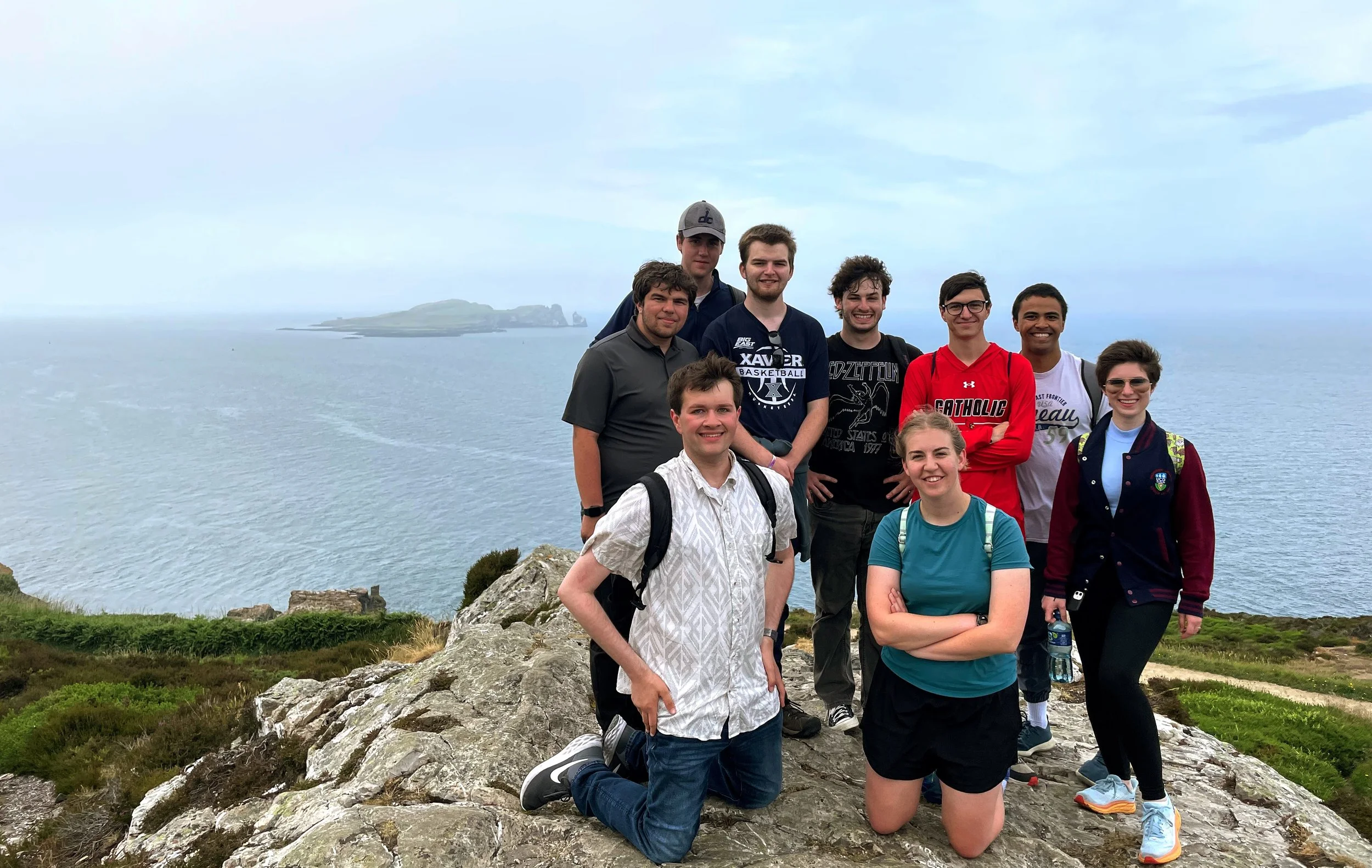Thanks a Million!
I had an amazing time in Ireland and would like to thank everyone who made this trip possible through your generous contributions during the spring raffle. I had the opportunity to visit many historical sites, and I even knit at some of them! Because you know me….. If I can’t bring my yarn, I’m not going! This post is just to share some of my general not quite crafty related highlights. Stay tuned for upcoming posts about my Aran sweater!
First of all, my trip to Ireland would not have been complete without a sheep sighting! On the first day of the trip as I was traveling by train from Dublin to Cork I saw a car dealership with sheep grazing in the field right next to it! To all my friends in the CUA costume shop, I’m sorry, but I could not figure out how to kidnap a sheep for each of you. But I hope this picture of sheep will suffice.
Given the fact that we had such a packed itinerary, I was relieved by the partial meal plan that was included in the tuition for the program. It turns out this very generous plan included only two meals over the course of the one month we were there. Surprise! So I did more of my own cooking than anticipated, which was an enjoyable challenge. As you may know from my Instant Failure post, I’m not the best cook in the kitchen. The month away from sibling harassment while cooking allowed me to grow in confidence in the kitchen. I even made the traditional mashed potatoes with bacon bits and cheddar cheese that my grandmother usually makes for my birthday.
This year was definitely the best birthday yet (and not just because I turned 21)! The group hiked around Howth with the jagged cliffs and sea to our left, and the beautiful rolling green hills to our right.
I suppose I should write a bit about the academics since this was a study abroad trip. Each of the excursions we went on was related to the coursework. Cobh, Cork, Kinsale, Kilkenny, and Howth were all just a bunch of names on the itinerary before I left for Ireland. Now that I have returned, they all hold a special place in my heart, and my experiences there solidified the information I learned in the classroom. At Cobh I stood where many took their last steps on Irish soil before immigrating to the U.S. At Charles Fort I could see James Fort across the water and imagine what must have been running through the minds of the soldiers during the siege of Kinsale.
Image taken in Charles Fort with James Fort across the way.A major theme throughout the first course–The Irish in the Theatre–was how art, particularly plays and performances were used to convey a political message or commentary on societal norms. At Kilkenny Castle I got a glimpse into the life of the Ormond family and the art they used to display their power. Like other Old English rulers in Ireland, the Ormonds included many classical motifs in their art collection to link the classical European history and tradition with that of England and Ireland.
Kilkenny Castle.The second course–The Invention of Ireland–focused on the 1916 Easter Rising and the Irish literary greats of the late 19th and early 20th century. We toured Kilmainham Gaol where the leaders of the rebellion were detained and executed. We also visited many places featured in Joyce’s Ulysses including the Martello tower where he stayed with some of his friends. This tower features in “Telemachus” which concludes with Buck Mulligan going for a swim in the “snotgreen sea.” It was a cold rainy day when we visited, but I could not pass up the opportunity to jump off the rock at the Forty Foot into the cold Irish sea! Visiting the places in and around Dublin connected to the novel and monumental moments in history made the stories in Ulysses and the events of the past come to life.
Interior of Martello Tower.I learned a lot in Ireland, not all of which was related to the coursework. So here are some fun facts!
This door is on display in Saint Patrick’s Cathedral. The door appears to have a window in the center, but this was not originally part of the door’s design. In 1492 the Butlers and Fizgeralds had a feud and the former locked themselves behind this door. Gerald Fizgerald offered a truce which the Butlers refused believing it to be a ruse. To prove his sincerity, Gerald had this hole cut in the door, thrust his hand in, and gave the Butlers two options: shake it, or cut it off. They shook his hand and this is where the phrase “to chance your arm” comes from.
This is some of the plasterwork in Malahide Castle. The master plaster worker had some apprentices whose job was to mix the alcohol with the powder to form the plaster. However, the apprentices drank the alcohol instead of mixing it, and this is supposedly where the term “plastered” comes from. You can see some fruit in this plasterwork. In Victorian times, pineapples were expensive imports that wealthy people would buy to display on their tables, or even rent out to other people. Consequently pineapples and other exotic fruits are popular Victorian motifs.
This is an image of Kilmainham Gaol which you may recognize from Paddington 2.
Glasnevin Cemetery has a population greater than that of Dublin. It’s a popular place that people are dying to get into.
This is a reading cage in Marsh’s Library where suspicious guests were locked in as they read and were inspected before they left to assure they did not steal any books.
As you can see, I enjoyed the trip and look forward to going back soon! Thanks a million, Ireland!
Subscribe to the newsletter to stay in the know about upcoming blog posts!











